Thinking about living in Bali with kids? That’s awesome! But make sure you’re ready. We spent three months in Bali with our two little girls, who were 1.5 and 5.5 years old at the time. We lived in Ubud and Canggu for six weeks each. That time taught us a lot—like how much we needed a break from Bali after!
In this blog post, I’ll share the real truth about living in Bali with kids as a digital nomad family, our personal experiences, and some handy tips I wish I’d known before we went.

Living in Bali with Kids: Why We Did the Move
We’ve been a digital nomad family since 2019, traveling the world since our oldest was 2 years old. Her sister joined the adventure in 2021 while we were in Thailand. We’ve spent most of our time in Southeast Asia, Australia, and New Zealand.
In 2023, after hearing so many glowing reviews from friends, both with and without kids, we decided to give Bali a try. Our plan was to live in Ubud from January to March.
Visa Drama: What You Need to Know
Since we decided to stay in Bali for three months, we had to dig deep into our pockets for the visa. We contacted the agency “Bali Visas” beforehand and started the visa process. The best option for us was to apply for the E-Visa “Single Entry Tourist Visa B211.” This visa was valid for up to 60 days, so we had to extend it once for another 60 days while in Bali to match our planned three-month stay.
I won’t go into all the details of the process here, but I have to say, this was the most expensive visa we’ve ever applied for as a digital nomad family for a short stay. In total, we paid 20,800,000 IDR (around 1,350 USD). Wow! And that doesn’t even include the costs for photos, trips to the agency, or visits to Immigration in Denpasar.
Finding Accommodation in Bali
Once we sorted out the visa situation, I started looking for a great place to live. I was so excited about the Balinese architecture and the open, bright lifestyle. But because Bali is flooded with tourists, the real estate prices have skyrocketed. We’re not just talking expensive; we’re talking insanely overpriced!
I first checked Facebook Marketplace and then got in touch with a few agents. For us, a perfect place included at least two bedrooms, in a quiet spot away from the main road, and, of course, a pool.
We found a villa that cost a hefty $3,000 a month, and that didn’t even include cleaning, electricity, or water. The worst part? Within days, we realized the place was completely covered in mold. You could smell it, and you could see it.
Unfortunately, mold is a common problem when living in Bali, especially in Ubud. Bali’s humidity often ranges from 70% to 90%, particularly during the rainy season. Mold thrives in these damp conditions, and without proper ventilation or dehumidifiers, the moisture just builds up in homes.
That’s one of the main reasons we fled Ubud after just six weeks and moved to Canggu. There, we were lucky enough to rent our friends’ new villa for the same price—but without mold and a lot nicer! Ideal for a small family living in Bali with kids like us.
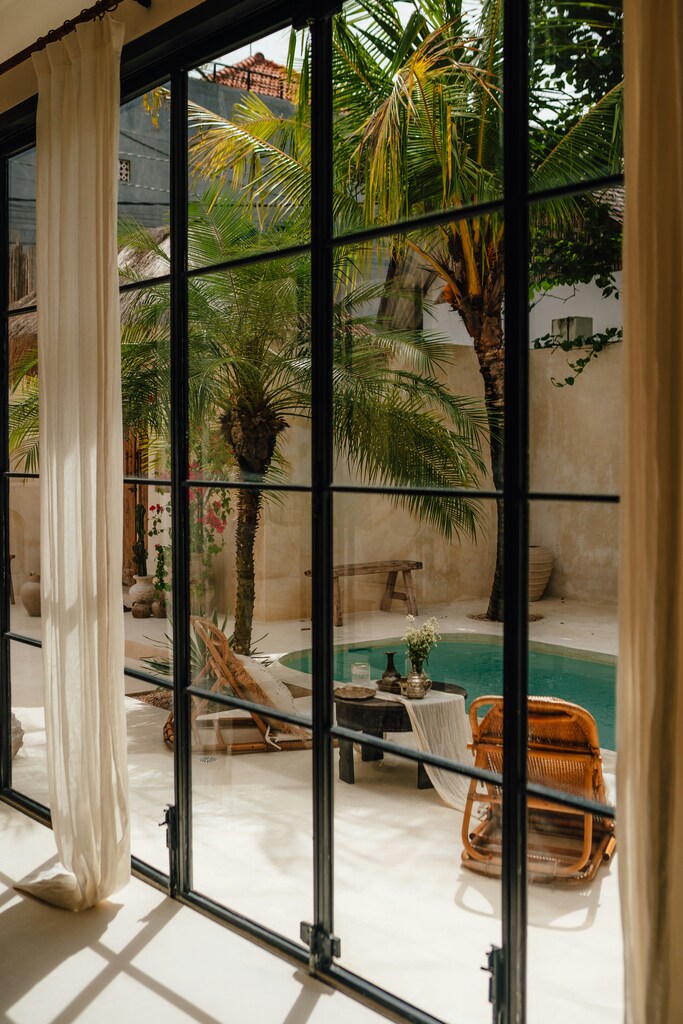
Living in Bali with Kids: Schools and Daycare
One of the biggest concerns when living in Bali with kids is finding good schools and daycare options. But here’s the good news: Bali is known for having some of the best schools in the world, as well as its quality of education and environmental focus. And that’s one of the reasons why so many parents decide to move here.
I found the process of getting school spots for my girls pretty easy. The Balinese international schools I contacted online responded quickly and clearly. Since our girls were only 1.5 and 5.5 years old at the time, I was looking for a kindergarten where English was spoken and catered to both age groups.
After some research and conversations, I chose Tirta Alam Bali School. It’s a sweet place with bamboo huts and a beautiful garden. Both foreign children and Balinese students attend, which made it a great choice for our family. We were absolutely happy and would recommend this school to everyone!
Later in Canggu, our youngest was looked after at home by a nanny while the older one went to Umalas Kids Club. This is a bigger school, and I think a French woman owns it. The only downside was that they couldn’t provide vegetarian meals for my daughter. That’s a bit of a dealbreaker nowadays.
Popular Schools in Bali
Here’s a list of the most popular and highly rated schools in Bali among Foreigners and Expat Families. The annual tuition ranges from 4,000 USD to 18,000 USD.
Curriculum: International Baccalaureate (IB), with a strong focus on sustainability and environmental education.
Location: Abiansemal, Badung
Mission: To empower students to be creative, innovative, and environmentally conscious, fostering global citizens who will make positive contributions to the world.
Curriculum: British-based curriculum, offering Cambridge IGCSE and IB Diploma Programme.
Location: Canggu
Mission: To provide a nurturing and inclusive learning environment that encourages academic excellence, critical thinking, and personal development.
Curriculum: International Baccalaureate (IB) from primary years to the IB Diploma Programme.
Location: Sanur
Mission: To develop internationally-minded students who are compassionate, reflective, and engaged global citizens, promoting both academic and personal growth.
Australian Independent School Bali (AIS)
Curriculum: Australian curriculum, leading to the New South Wales Higher School Certificate (HSC).
Location: Denpasar
Mission: To provide a high-quality education that prepares students for lifelong learning, equipping them with the skills needed to succeed in a global environment.
Curriculum: British curriculum, specializing in small class sizes and personalized learning plans.
Location: Umalas
Mission: To provide a student-centered learning environment that respects individual differences and supports the holistic development of each child.
Curriculum: Montessori philosophy, with mixed-age classrooms and a hands-on learning approach.
Location: Canggu
Mission: To empower children to reach their full potential through hands-on learning, fostering independence, respect, and self-discipline.
French School Bali (École Internationale Française de Bali)
Curriculum: French national curriculum.
Location: Kerobokan
Mission: To provide an excellent education rooted in French culture while promoting multilingualism and global citizenship.
Curriculum: Bilingual curriculum (Indonesian and English), offering Cambridge IGCSEs and the Indonesian National Curriculum.
Location: Sanur
Mission: To inspire students to achieve academic excellence while fostering social responsibility and a sense of community through bilingual education.
Curriculum: International and Montessori-based curriculum with an emphasis on emotional intelligence and holistic development.
Location: Ubud
Mission: To create a harmonious learning environment where students develop not only intellectually but also emotionally, fostering empathy, collaboration, and mindfulness.
Curriculum: International curriculum with a focus on social-emotional learning and conflict resolution.
Location: Canggu
Mission: To develop compassionate and responsible individuals by teaching students the values of empathy, kindness, and global citizenship.
Curriculum: Nature-based and project-based learning with a focus on sustainability and outdoor education.
Location: Canggu
Mission: To nurture a deep connection to nature while promoting creativity and hands-on learning, helping students grow into environmentally conscious and innovative thinkers.
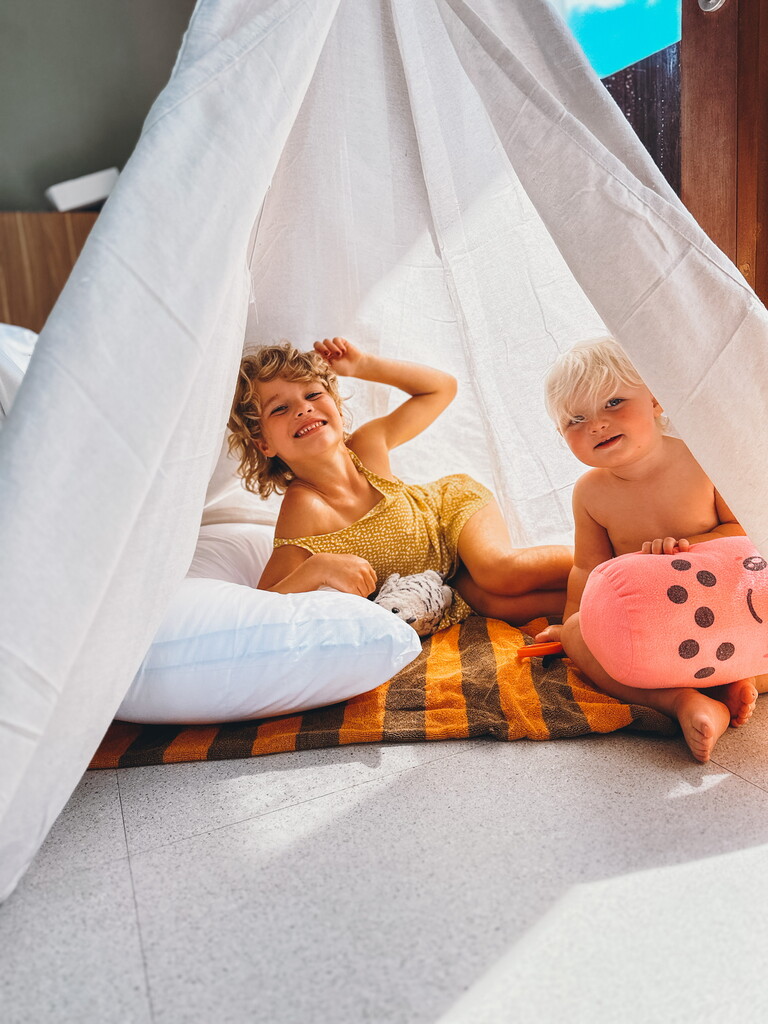
Hiring Nannies in Bali
Finding great nannies when living in Bali was surprisingly easy for me and affordable at a reasonable price. Normally, this is one of my least favorite tasks whenever we move to a new place. But in Bali, it was a total breeze.
Here’s how I usually do it: First, I post in the local Facebook parents’ group that I’m looking for a nanny. I include all the details like specific requirements, hours, and salary expectations. Then, I wait to see who responds. Often, people recommend nanny agencies, which I personally prefer. It gives me more confidence that the nanny will be well-trained and that payments will be handled professionally.
In both Ubud and Canggu, we worked with Bali Angel Holiday. The owner, Vera, found us amazing nannies who were simply fantastic. We paid 65,000 IDR per hour (around $4.20 USD) plus a travel fee of 50,000 IDR per day (about $3.20 USD).

Is Living in Bali with Kids Affordable?
Compared to places like Thailand and Vietnam, Bali was really expensive for us. But it’s a good thing to remember you are paying for things you hardly get elsewhere in Indonesia, like that kind of luxury, for example.
To give you a clear picture, I’ve put together cost breakdowns for our time in Ubud and Canggu. All costs are monthly and don’t include expenses for memberships, subscriptions, health insurance, and retirement plans.
Monthly Cost of Living in Ubud
🏠 Housing: 50.000.000 IDR (3.410 USD) – 3bdr Villa with Pool in the east of Ubud
🛒 Groceries: 2.790.000 IDR (190 USD) – supermarkets and local markets
🥗 Restaurants: 20.839.000 IDR (1.420 USD) – mostly Western food
🛵 Transportation: 5.200.000 IDR (354 USD) – we rented 1 Scoopy and 1 PCX from Bikago
👶 Childcare: 20.705.000 IDR (1.411 USD) – every day at a local school + nannies
🏋️ Sport: 5.200.000 IDR (354 USD) – memberships at Parq
💻 Co-Working: 1.400.000 IDR (95 USD) – day passes at different Co-Working spaces
💆♀️ Personal Care: 2.970.000 IDR (202 USD) – massages, nails, hairdresser/barber
🥳 Fun & Activities: 2.235.000 IDR (152 USD) – e.g., parties, water park, water sports
_____________________
💸 Total: 111.339.000 IDR = 7.595 USD
Monthly Cost of Living in Canggu
🏠 Housing: 50.000.000 IDR (3.410 USD) – 4bdr Villa with Pool in Umalas
🛒 Groceries: 3.305.000 IDR (225 USD) – Pepito and local markets
🥗 Restaurants: 26.082.000 IDR (1.779 USD) – mostly western food
🛵 Transportation: 5.105.000 IDR (348 USD) – we rented 1 Scoopy and 1 PCX from Bikago
👶 Childcare: 19.040.000 IDR (1.298 USD) – every day at international schools + nannies
🏋️ Sport: 3.219.000 IDR (219 USD) – day passes at multiple gyms
💻 Co-Working: 1.935.000 IDR (131 USD) – memberships at Tropical Nomad and other Co-Working spaces
💆♀️ Personal Care: 2.450.000 IDR (167 USD) – massages, nails, hairdresser/barber
🥳 Fun & Activities: 3.365.000 IDR (229 USD) – e.g. parties, watersports
_____________________
💸 Total: 114.501.000 IDR = 7.809 USD

Traffic: Driving Scooters in Bali with Kids
Now we come to the worst part: traffic! This can be a real challenge when living in Bali, especially with young kids. You’ve probably seen videos of the famous Canggu Shortcut. Yep, it’s not just a snapshot. It really is that bad in the tourist areas, almost every day and at almost any time.
Sure, you could argue, “Well, just don’t move to the most touristy spots on the island!” Fair point. But those areas have the best infrastructure for family life.
Since we’re experienced scooter riders, we rented scooters right away. Honestly, I think we saved a lot of time because you can get through traffic much faster on a scooter. I definitely wouldn’t recommend renting a car. We used a car taxi only for long trips, like going to Denpasar for the immigration office or to the airport.
But even with a scooter, sometimes it’s just unbearable. For short trips of about 3 kilometers, you can easily plan for a half-hour ride. And that’s in the blazing heat, with average temps around 86°F (30°C). That was the main downside of living in Bali for us.
Tips for Staying Safe in Bali Traffic
1. Avoid Main Roads During Peak Hours: Bali’s main roads, especially in areas like Kuta, Seminyak, Ubud, Canggu and Denpasar, can become extremely congested during peak hours (7-9 AM and 4-7 PM). Opt for smaller side streets or jalan tikus (rat paths) to bypass traffic and get to your destination faster.
2. Plan Your Routes in Advance: Use apps like Google Maps to plan your route ahead. This helps avoid traffic hotspots and ensures you’re taking the quickest path. Local apps or groups sometimes share real-time traffic updates too.
3. Be Mindful of Potholes and Road Conditions: Many roads in Bali, especially less traveled ones, can be uneven, with potholes or debris. Scan the road ahead constantly and ride cautiously when entering unknown streets.
4. Ride with the Flow of Traffic: This is my favorite tip for riding a scooter in Asia in general! Don’t weave in and out of traffic too aggressively, even if you want to go fast. Staying with the flow helps you avoid accidents and sudden stops, especially in busy areas. Sometimes when I’m in a hurry, I have to tell myself to stay in the flow to stay safe.
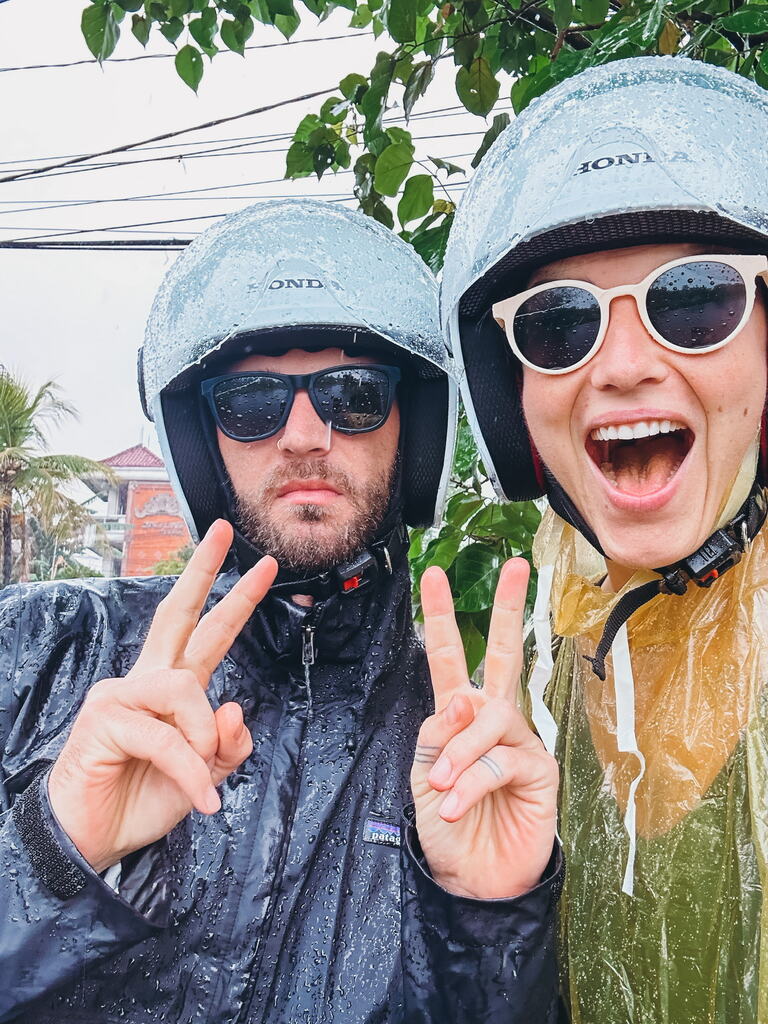
Living in Bali with Kids: The Best Areas for Families
The best places for living in Bali with kids depend on your family’s needs. My personal opinion: Even though some of the best schools are there, I wouldn’t move to Ubud with my family again. The traffic felt even worse, and the weather was more oppressive. Maybe we didn’t give the area enough of a chance, I’m not sure.
Canggu, on the other hand, I’d do again in a heartbeat. The fresh ocean breeze and slightly better traffic made a huge difference in our quality of life.
Anyways, here are some top recommendations for family-friendly areas:
1. Sanur – Best for a Calm Family Life
30% of expat families choose Sanur as their home base in Bali, and it’s easy to see why. Sanur has beautiful beaches, perfect for small children to play safely. The long beachfront promenade is ideal for bike rides and family walks. Plus, Sanur has several international schools nearby, like Bali Island School, which is great if you’re planning to stay long-term.
2. Canggu – Trendy and Fun for Active Families
Canggu is popular with digital nomads, but it’s also becoming a hub for families who love a vibrant and active lifestyle. There are tons of trendy cafes with playgrounds, and plenty of activities like surfing lessons for kids, yoga for moms, and beach days for the whole family. Canggu has a strong sense of community, with local schools like Montessori Bali and Green School Bali nearby. Fun fact: Canggu has the highest concentration of international schools in Bali, making it super convenient for families.
3. Ubud – Best for Nature-Loving Families
For those who love nature, Ubud offers natural beauty with its rice terraces and lush jungle hills. Ubud is a great spot for families who enjoy a slower pace of life. There are lots of kid-friendly activities, from visiting rice paddies to taking part in arts and crafts workshops. Ubud is also home to several organic markets, yoga studios, and wellness centers that offer classes for kids and parents. If you’re into healthy living and want your kids to be close to nature, Ubud is perfect!
Discover the top non-touristy things to do in Ubud right here!
4. Seminyak – Stylish Living with Kid-Friendly Perks
Seminyak is known for being stylish, but it’s also great for families. The area offers easy access to some of Bali’s best amenities, like international schools, medical clinics, and shopping centers. There are also plenty of family-friendly restaurants, and it’s close to fun spots like Waterbom Bali and Finns Recreation Club, where kids can spend hours playing. While it’s a bit more urban, families love Seminyak for its convenience, and central location.
5. Jimbaran – Great for a Quiet, Beachy Lifestyle
Jimbaran, with its rich culture and relaxed vibe, is ideal for families who want a quieter life in Bali. It’s known for its beautiful sunsets on the long beaches. The area has a mix of luxury villas and affordable housing. Jimbaran offers a slower pace of life with easy access to places like Uluwatu for weekend adventures.
Family Fun in Bali: Best Activities with Kids
Bali has so much to offer for families! I was really impressed by all the kid-friendly beach clubs, the restaurants and cafes with playgrounds, and the many workshops and activities for kids, especially the outdoor ones.
When it comes to that, Bali is super modern and has the best infrastructure I’ve seen in Southeast Asia (maybe apart from Singapore).
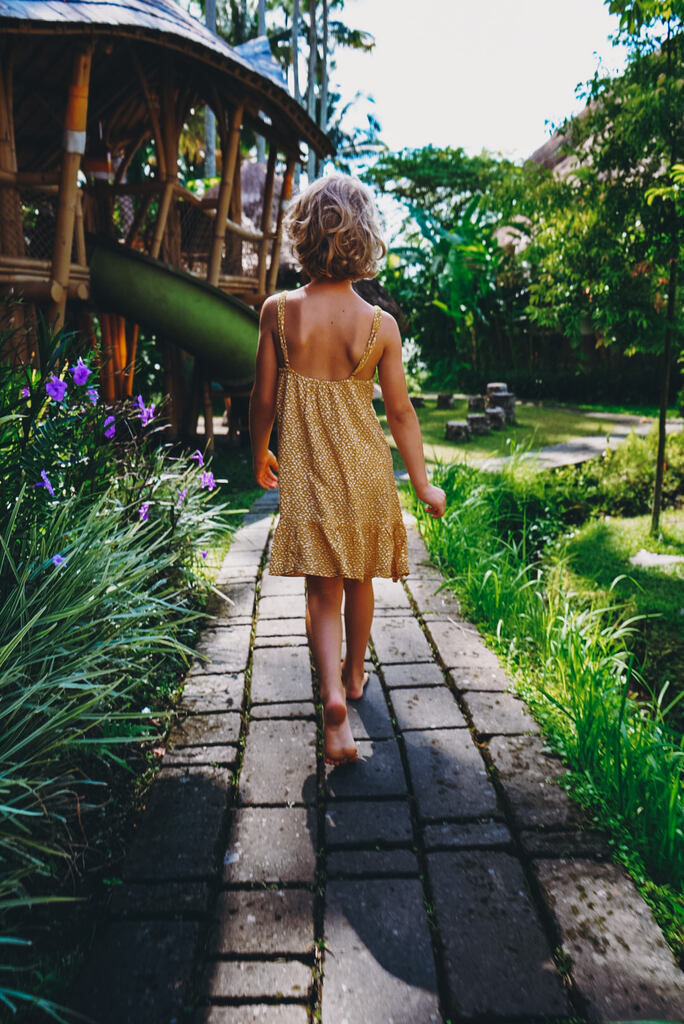
Here are my favorite activities and places in Bali with kids:
1. Waterbom Bali: Bali’s most famous waterpark, Waterbom, is undoubtedly the best thing for kids in Bali. At least, that’s what our girls say. It’s full of slides, pools, and lazy rivers that will keep kids (and adults!) happy all day. There are also great food options and shaded spots for a little rest.
2. Bali Wake Park: For older kids who love adventure, Bali Wake Park offers wakeboarding, kneeboarding, and a giant inflatable playground on water! It’s safe, supervised, and tons of fun for active kids.
3. Monkey Forest in Ubud: For a unique experience, head to Monkey Forest in Ubud. It’s a magical place where kids can see monkeys in their natural habitat. Just watch out – these monkeys can be cheeky, so keep your snacks hidden!
4. Cafes with Playgrounds: Bali is full of family-friendly cafes with playgrounds where parents can relax while the kids play. My favorite is Milk and Madu in Canggu, which has a wooden playground and plenty of space for kids to run around. Mana Kitchen in Ubud is another great option, with a big outdoor play area and delicious food.
5. Titi Batu Ubud: Titi Batu is a fantastic family-friendly spot in Bali, especially if you’re looking for a mix of fun and relaxation. It’s a sports and wellness club with a great kids’ area, including a pool, playground, and even a skate park for those who like to be active. But the highlight for kids? The weekly foam parties! Once a week, Titi Batu turns into a foam-filled wonderland where kids can jump around, splash, and have the best time in the bubbles.
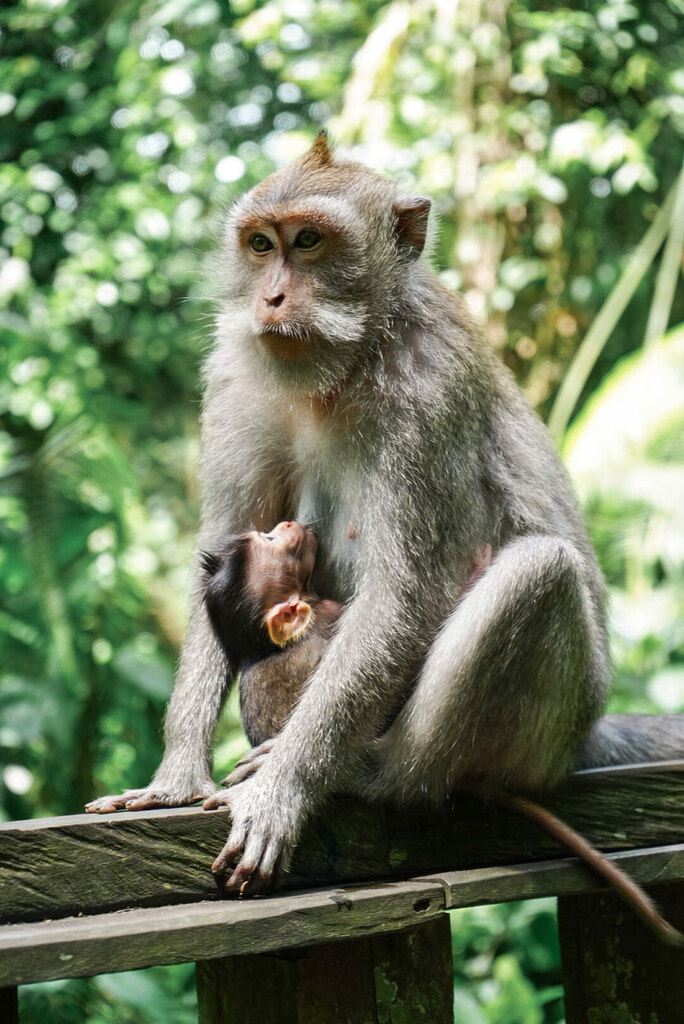
Healthcare: Yes, the Bali Belly is Real!
Yes, unfortunately, it is. We’ve been traveling around full-time in Southeast Asia since 2019, so our bodies are pretty used to the local hygiene, water, and food quality. But still, we all got the Bali Belly. My husband had it the worst. He was down for three days with bad stomach cramps, fever, and diarrhea. The kids and I just had mild symptoms with a bloated belly and occasional stomach aches.
I don’t think Bali Belly can be avoided entirely. If it gets too bad, I’d suggest seeing a doctor quickly. With a stool sample (yep, I know, yummy), they can figure out what germ it is and prescribe the proper medication.
Balinese People and Culture
We absolutely loved the Balinese people when living in Bali. They were incredibly friendly (and attractive, by the way!). In almost every restaurant, our kids were picked up or playfully engaged with by the locals, which made us feel very welcome. And don’t worry about the language barrier —Balinese people speak very good English, so communication was never an issue.
In Bali, the Hindu religion is visible everywhere. You’ll notice small woven baskets filled with flowers, rice, and incense placed outside homes, shops, and temples as daily offerings to the gods (try not to step on them!). Temples, large and small, are scattered across the island, and it’s common to see locals stopping by to pray.
Balinese people often dress in traditional attire for temple visits or religious ceremonies, which happen regularly. Our Nanny in Canggu gave us some sets of traditional clothes so we could wear them at the Ogoh-ogoh Parade, the day after Nyepi (silent day in March).
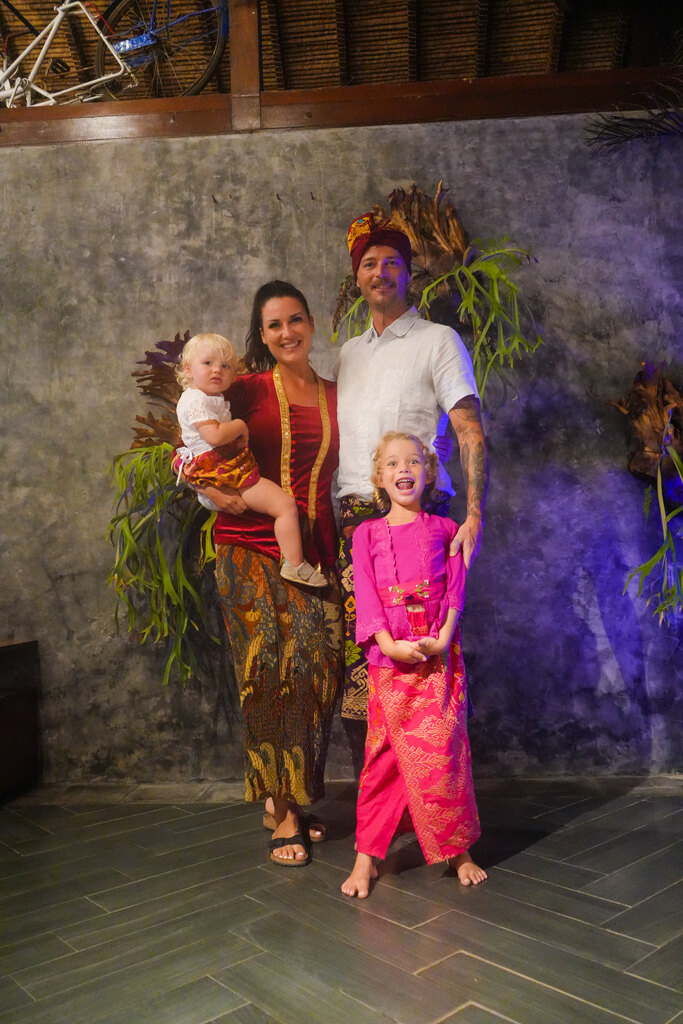
Bali Weather: What to Expect
The tropical climate is something to get used to when living in Bali with kids. It means warm weather all year round, with temperatures usually ranging between 77°F and 90°F. There are two main seasons to keep in mind—the dry season and the rainy season. The dry season, from April to October, is perfect for outdoor fun like beach days and exploring rice terraces. It’s sunny and not too humid, making it the best time for families to enjoy the island.
The rainy season, from November to March, brings daily showers, but don’t worry—it usually rains for just a couple of hours, and you can still enjoy the rest of the day.
Final Thoughts on Living in Bali with Kids: Is Bali Right for Your Family?
You can tell, my opinion about living in Bali with kids is pretty mixed. The island has so many amazing sides and advantages for families. But just as many downsides too. Honestly, after living there for three months, we were ready to move on. We were craving less traffic and a more convenient lifestyle.
But now, a year and a half later, I’m already itching to go back. I miss the luxury, the food, the people, and the great schools.
Are you thinking about living in Bali with kids for a longer period of time? What are your concerns? Let me know in the comments!
Thanks so much for reading and for making me a part of your day!
Yours, Lulu

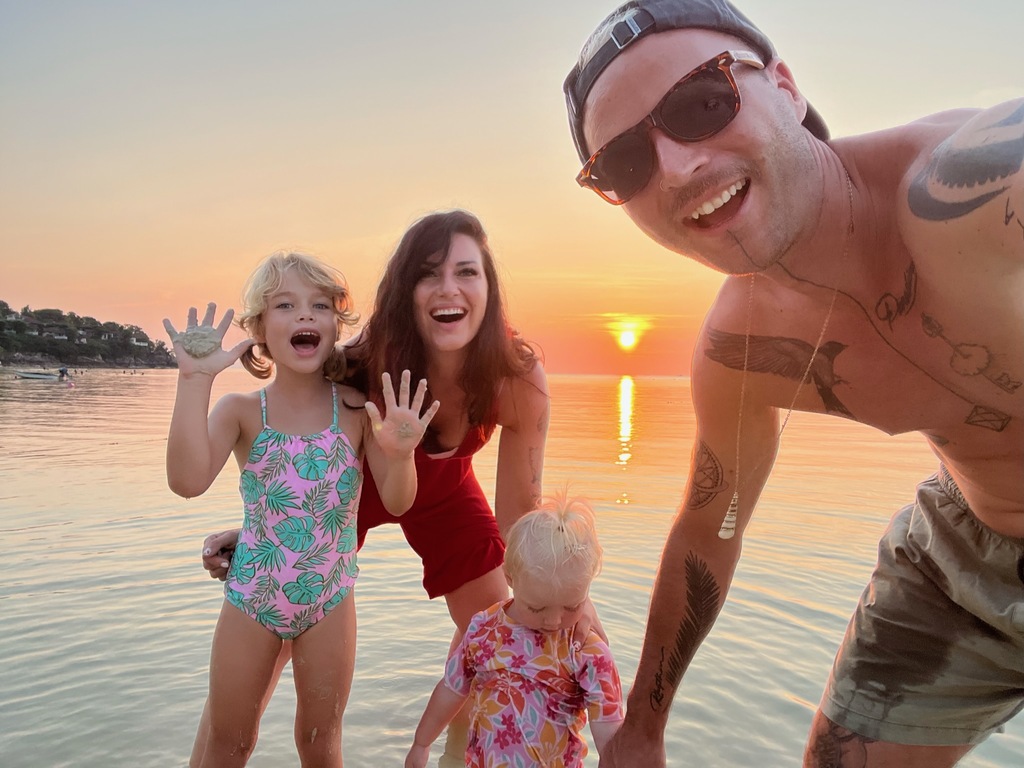



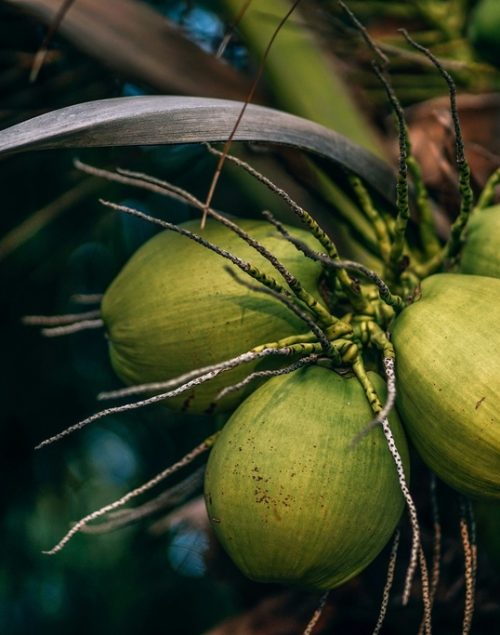
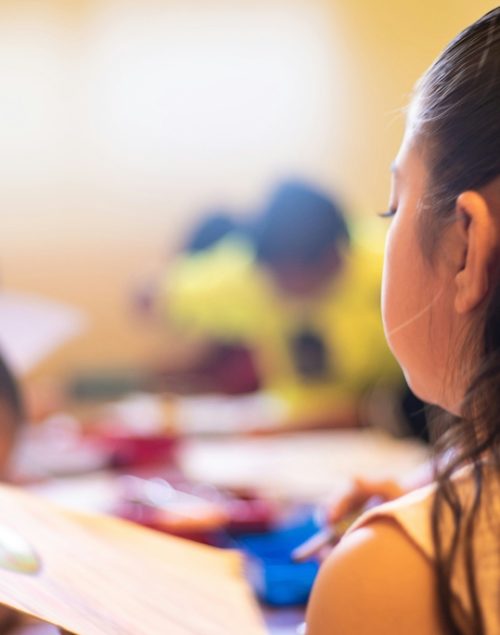
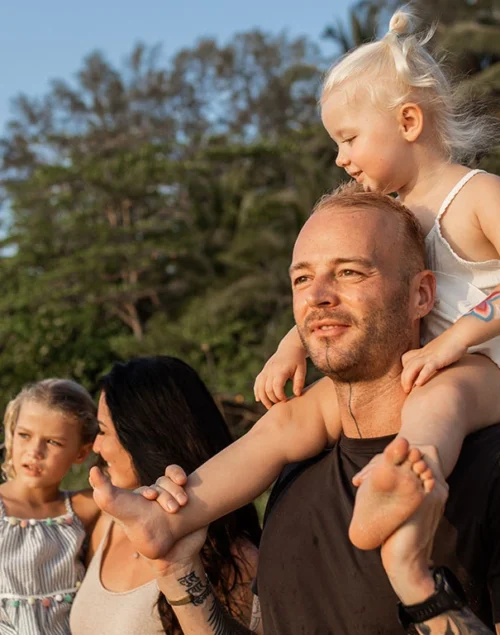


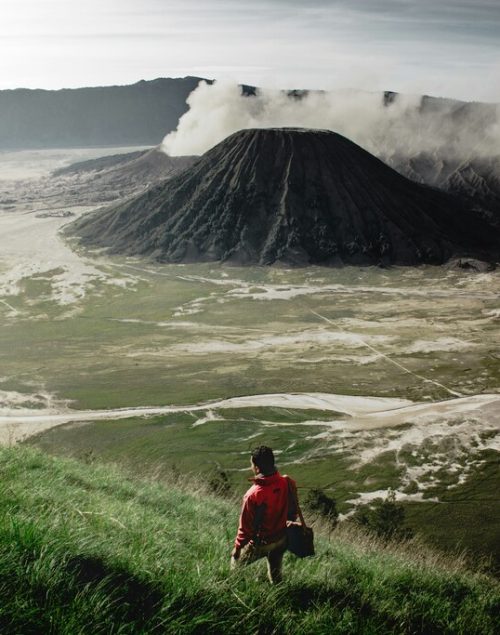


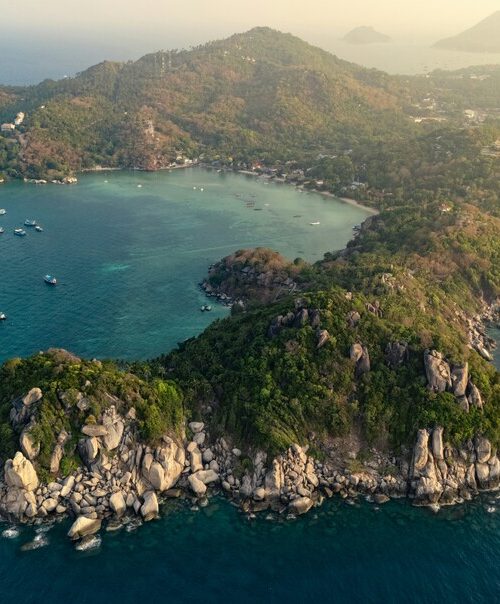

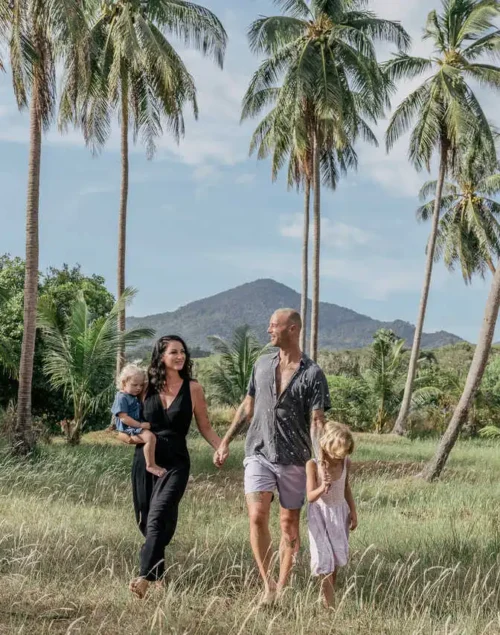
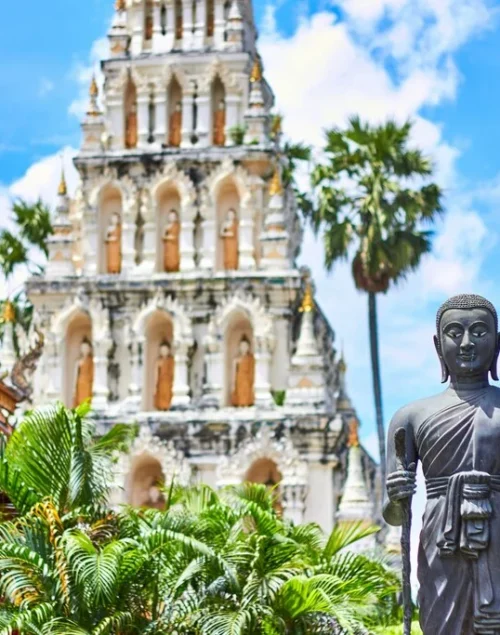
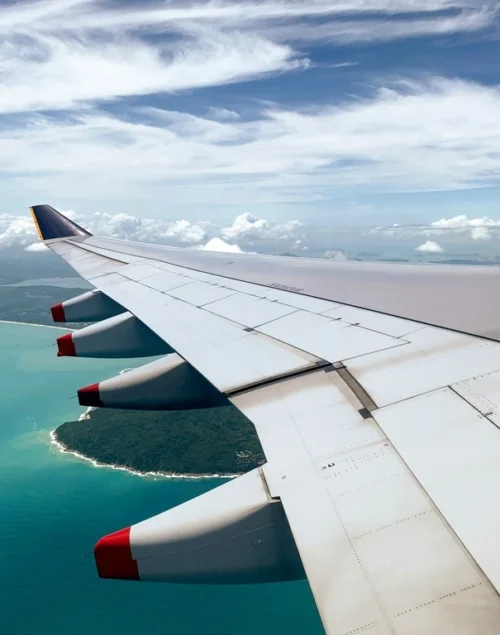
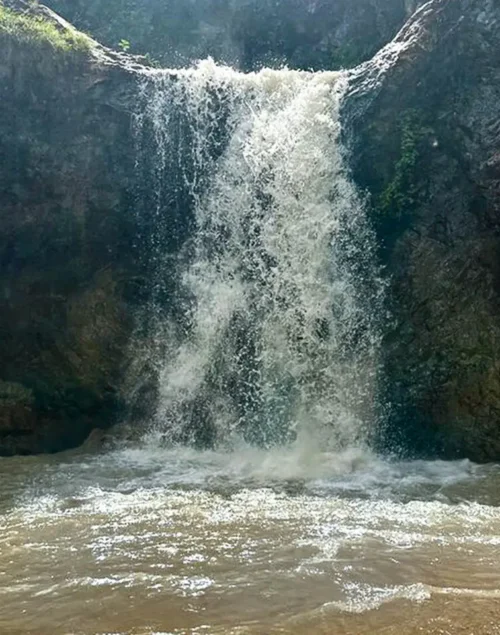

1 thought on “The Honest Truth About Living in Bali with Kids”
Aw, this was an exceptionally nice post. Taking the time and actual effort to produce a good article… but what can I say… I hesitate a lot and don’t seem to get
anything done.